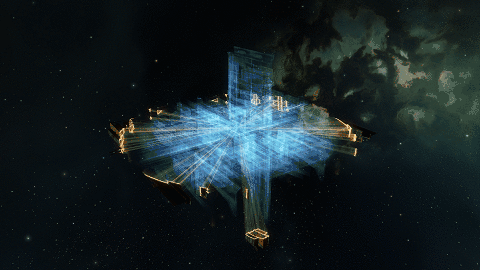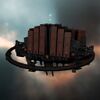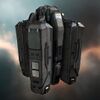Difference between revisions of "Anchoring"
Tones badasz (talk | contribs) (Added subheadings and tidied up some of the language.) |
(→Skills) |
||
| (14 intermediate revisions by 10 users not shown) | |||
| Line 1: | Line 1: | ||
| − | + | [[File:RaitaruAnchorSmall.gif|thumb|480px|Anchoring Raitaru Engineering Complex]] | |
| + | '''Anchoring''' is the act of placing permanent structures in space for a variety of uses. These structures play an important role in EVE Online in both PvE and PvP content. | ||
| + | == Skills == | ||
| − | + | The following skill is required to anchor most mobile structures. Upwell structures, mobile depots and mobile tractor units do not need any skills to deploy. | |
| − | |||
| + | * {{sk|Anchoring|mult=yes}} - Skill at Anchoring deployables. | ||
| − | [[ | + | Most new players will only need to have this skill at level 1 for anchoring [[Containers#Secure container & audit log secure container|secure containers]] in space (in solar systems with security level below 0.8). However, once you are deeper in your EVE career, you may want to continue training this skill. Below is a breakdown of what you can use with each levels of the anchoring skill: |
| + | * '''Secure Containers''' - (Level I) | ||
| + | * '''Player Owned Starbase (POS) Structures''' (control towers, laboratories, maintenance arrays, refineries, etc.) require Level 1, with the exception of: | ||
| + | ** '''Reactor Arrays''' - (Level II) | ||
| + | ** '''Shield Hardening Arrays''' - (Level II) | ||
| + | ** '''All ECM Projection Batteries (Ion Field/White Noise Generator/Spacial Destabilization/Phase Inversion)''' - (Level 3) | ||
| + | * '''Warp Bubbles''': The bigger it is and higher tech level, the higher anchoring skill you will need, ranging from | ||
| + | ** '''Mobile Small Warp Disruptor I''' - (Level II) | ||
| + | ** '''Mobile Small Warp Disruptor II''' - (Level III) | ||
| + | ** '''Mobile Large Warp Disruptor I''' - (Level IV) | ||
| + | ** '''Mobile Large Warp Disruptor II''' - (Level V) | ||
| − | + | == Upwell Structures == | |
| + | {{main|Upwell structures}} | ||
| − | + | Upwell structures are the latest iteration of anchorables, which started being added to the game with the citadel expansion. These structures were gradually introduced into the game as a way to replace the existing player owned starbases and expand on what they originally provided. You do not require any skills to deploy Upwell structures. | |
| + | [[File:Astrahus.jpg|thumb|100px|left]] | ||
| + | === Citadels === | ||
| − | + | Citadels are Upwell Structures meant to be used as operation bases. They receive bonuses to combat rig effectiveness, market service fuel usage and cloning bay fuel usage. Citadels also have the shortest vulnerability durations and strongest combat options making them easier to defend. | |
| + | The three citadels are Astrahus (medium), Fortizar (large) and Keepstar (extra large). They have exactly same structure bonuses so the difference is only how much things they can have fitted and how much of a status symbol they are. | ||
| − | |||
| − | |||
| − | |||
| + | [[File:Athanor.jpg|thumb|100px|left]] | ||
| + | === Refineries === | ||
| − | + | Refineries are structures of choice for refining materials, reactions and moon mining. These are the only structures that can do reactions or moon mining and also receive innate bonuses to refining yields and both reprocessing and refining service module fuel consumption. The two refineries are Athanor (medium) and Tatara (large). The Athanor docking is limited to only subcapitals while Tatara also allows Rorquals to dock. | |
| − | |||
| − | |||
| − | |||
| − | === | + | [[File:Raitaru.jpg|thumb|100px|left]] |
| + | === Engineering Complex === | ||
| − | + | Engineering complexes are the structures of choice for research and manufacturing. Research and manufacturing services installed in engineering complexes consume less fuel. In addition the engineering complexes have innate bonuses to manufacturing material usage, manufacturing and science job duration's and manufacturing and science job installation fees. | |
| − | + | The three engineering complexes are Raitaru (medium), Azbel (large) and Sotiyo (extra-large). All three limit their docking to battleships and below so once a built capital ship comes out it can not go back in. | |
| − | |||
| − | |||
| − | |||
| − | |||
| − | |||
| − | |||
| − | |||
| − | |||
| − | |||
| − | [[ | + | [[File:Ansiblex.jpg|thumb|100px|left]] |
| + | === Navigation Structures === | ||
| + | {{main|Navigation structures}} | ||
| + | |||
| + | Navigation structures are part of the Upwell Fast Logistical Expansion (FLEX) structures and currently the only FLEX structures. The three navigational structure types are the Ansiblex Jump Gate, the Pharolux Cyno Beacon, and the Tenebrex Cyno Jammer. | ||
| + | |||
| + | |||
| + | |||
| + | |||
| + | |||
| + | |||
| + | == Mobile Structures == | ||
| + | {{main|Mobile structures}} | ||
| + | Mobile Structures are deployable structures deployed by individual pilots to provide a wide variety of services. Players can use these structures for a variety of things, such as providing storage and replacing functionality of fitted modules. They can also be used to disrupt enemies through starbase siphoning, jamming probes and cynosural fields. Some of the most common mobile structures include mobile tractor units and mobile depots. There are many other mobile structures, covered in depth in their own article. | ||
| + | |||
| + | [[File:Mobile_Depot.jpg|100px|thumb|left]] | ||
| + | === Mobile Depot === | ||
| + | |||
| + | A Mobile Depot is a mobile structure designed to provide fitting and storage services to its owner. Once you deploy a depot, you can use it to refit your ship's modules and subsystems, move items between it and your cargohold, and move drones between your cargohold and drone bays. A mobile depot takes up only 50 m3 of space and will easily fit in most frigates. It can hold between 3,000 and 4,000 m3 once deployed. | ||
| + | |||
| + | Deploying a mobile depot takes 60 seconds. Once in space, it will last for 30 days, at which point it will vanish with its contents. However, interacting with it will reset this 30-day timer, so remember to bookmark it. It can be scooped into your ship's cargohold at any time. Anything that was in the mobile depot before you picked it up will appear in space in a cargo container. A mobile depot can only be accessed or scooped up by its owner; you cannot launch it for use by other players. | ||
| + | |||
| + | |||
| + | [[File:Mobile_Tractor_Unit.jpg|100px|thumb|left]] | ||
| + | === Mobile Tractor Unit === | ||
| + | |||
| + | A Mobile Tractor Unit (or MTU) is a mobile structure designed to operate as a replacement to equipping a tractor beam on your ship. Once deployed, it uses a single tractor beam to pull in any wrecks and cargo containers. It has a range of 125 km, with a 1,000 m/sec tractor velocity, and a 27,000 m3 cargohold. Deployment time is only 10 seconds, and the MTU will last 2 days in space before despawning. The MTU is only accessible by its owner. When destroyed it drops partial loot the same way a destroyed ship does. | ||
| + | |||
| + | The MTU may not be deployed within 5 km of another MTU, within 50 km of stargates or stations, or within 40 km of a player owned starbase. | ||
| + | |||
| + | |||
| + | |||
| + | |||
| + | == Player Owned Starbases == | ||
| + | {{main|POS}} | ||
| + | [[File:Caldari_Control_Tower.jpg|100px|thumb|left]] | ||
| + | |||
| + | |||
| + | Player-owned starbases (often shortened to "starbase" or "POS") are structures that player corporations may anchor in the orbit of moons. Starbases are the precursor to the current Upwell structures. While starbases and starbase structures can still be deployed at this time, they will soon be removed from the game as they have been replaced functionally by Upwell structures. A player cannot dock with a starbase; they can only interact with the starbase modules. | ||
| + | |||
| + | A starbase and its structures can fulfill many of the functions of stations. It is possible to store and refit ships, refine ore, or manufacture modules, ships and other items. Prior to Upwell structures being added to the game, starbase structures gave certain bonuses to manufacturing and research. These bonuses were removed by CCP in order to incentivize players to switch over to the new Upwell structures. | ||
| + | |||
| + | |||
| + | |||
| + | |||
| + | == Useful Links== | ||
| + | |||
| + | [[Anchoring structures]] - A detailed guide on deploying an Upwell structure in space. | ||
| + | |||
| + | [https://www.youtube.com/watch?v=6tILdCWVb-c Delonewolf's Guide to Deploying an Astrahus (video)] | ||
| + | |||
| + | [https://www.youtube.com/watch?v=GhbMSGRHPeM Citadels Explained by EveBusinessInsider (video)] | ||
| + | |||
| + | [https://www.youtube.com/watch?v=388MSR6xl54 Player Owned Starbases Explained by EveBusinessInsider (video)] - Included for those curious about POS structures. Note that these will soon be removed from the game entirely and have been functionally replaced by Upwell structures. | ||
| + | |||
| + | |||
| + | [[Category:Structures]] | ||
Latest revision as of 22:07, 23 December 2023
Anchoring is the act of placing permanent structures in space for a variety of uses. These structures play an important role in EVE Online in both PvE and PvP content.
Contents
Skills
The following skill is required to anchor most mobile structures. Upwell structures, mobile depots and mobile tractor units do not need any skills to deploy.
- Anchoring (3x) - Skill at Anchoring deployables.
Most new players will only need to have this skill at level 1 for anchoring secure containers in space (in solar systems with security level below 0.8). However, once you are deeper in your EVE career, you may want to continue training this skill. Below is a breakdown of what you can use with each levels of the anchoring skill:
- Secure Containers - (Level I)
- Player Owned Starbase (POS) Structures (control towers, laboratories, maintenance arrays, refineries, etc.) require Level 1, with the exception of:
- Reactor Arrays - (Level II)
- Shield Hardening Arrays - (Level II)
- All ECM Projection Batteries (Ion Field/White Noise Generator/Spacial Destabilization/Phase Inversion) - (Level 3)
- Warp Bubbles: The bigger it is and higher tech level, the higher anchoring skill you will need, ranging from
- Mobile Small Warp Disruptor I - (Level II)
- Mobile Small Warp Disruptor II - (Level III)
- Mobile Large Warp Disruptor I - (Level IV)
- Mobile Large Warp Disruptor II - (Level V)
Upwell Structures
- Main article: Upwell structures
Upwell structures are the latest iteration of anchorables, which started being added to the game with the citadel expansion. These structures were gradually introduced into the game as a way to replace the existing player owned starbases and expand on what they originally provided. You do not require any skills to deploy Upwell structures.
Citadels
Citadels are Upwell Structures meant to be used as operation bases. They receive bonuses to combat rig effectiveness, market service fuel usage and cloning bay fuel usage. Citadels also have the shortest vulnerability durations and strongest combat options making them easier to defend.
The three citadels are Astrahus (medium), Fortizar (large) and Keepstar (extra large). They have exactly same structure bonuses so the difference is only how much things they can have fitted and how much of a status symbol they are.
Refineries
Refineries are structures of choice for refining materials, reactions and moon mining. These are the only structures that can do reactions or moon mining and also receive innate bonuses to refining yields and both reprocessing and refining service module fuel consumption. The two refineries are Athanor (medium) and Tatara (large). The Athanor docking is limited to only subcapitals while Tatara also allows Rorquals to dock.
Engineering Complex
Engineering complexes are the structures of choice for research and manufacturing. Research and manufacturing services installed in engineering complexes consume less fuel. In addition the engineering complexes have innate bonuses to manufacturing material usage, manufacturing and science job duration's and manufacturing and science job installation fees.
The three engineering complexes are Raitaru (medium), Azbel (large) and Sotiyo (extra-large). All three limit their docking to battleships and below so once a built capital ship comes out it can not go back in.
- Main article: Navigation structures
Navigation structures are part of the Upwell Fast Logistical Expansion (FLEX) structures and currently the only FLEX structures. The three navigational structure types are the Ansiblex Jump Gate, the Pharolux Cyno Beacon, and the Tenebrex Cyno Jammer.
Mobile Structures
- Main article: Mobile structures
Mobile Structures are deployable structures deployed by individual pilots to provide a wide variety of services. Players can use these structures for a variety of things, such as providing storage and replacing functionality of fitted modules. They can also be used to disrupt enemies through starbase siphoning, jamming probes and cynosural fields. Some of the most common mobile structures include mobile tractor units and mobile depots. There are many other mobile structures, covered in depth in their own article.
Mobile Depot
A Mobile Depot is a mobile structure designed to provide fitting and storage services to its owner. Once you deploy a depot, you can use it to refit your ship's modules and subsystems, move items between it and your cargohold, and move drones between your cargohold and drone bays. A mobile depot takes up only 50 m3 of space and will easily fit in most frigates. It can hold between 3,000 and 4,000 m3 once deployed.
Deploying a mobile depot takes 60 seconds. Once in space, it will last for 30 days, at which point it will vanish with its contents. However, interacting with it will reset this 30-day timer, so remember to bookmark it. It can be scooped into your ship's cargohold at any time. Anything that was in the mobile depot before you picked it up will appear in space in a cargo container. A mobile depot can only be accessed or scooped up by its owner; you cannot launch it for use by other players.
Mobile Tractor Unit
A Mobile Tractor Unit (or MTU) is a mobile structure designed to operate as a replacement to equipping a tractor beam on your ship. Once deployed, it uses a single tractor beam to pull in any wrecks and cargo containers. It has a range of 125 km, with a 1,000 m/sec tractor velocity, and a 27,000 m3 cargohold. Deployment time is only 10 seconds, and the MTU will last 2 days in space before despawning. The MTU is only accessible by its owner. When destroyed it drops partial loot the same way a destroyed ship does.
The MTU may not be deployed within 5 km of another MTU, within 50 km of stargates or stations, or within 40 km of a player owned starbase.
Player Owned Starbases
- Main article: POS
Player-owned starbases (often shortened to "starbase" or "POS") are structures that player corporations may anchor in the orbit of moons. Starbases are the precursor to the current Upwell structures. While starbases and starbase structures can still be deployed at this time, they will soon be removed from the game as they have been replaced functionally by Upwell structures. A player cannot dock with a starbase; they can only interact with the starbase modules.
A starbase and its structures can fulfill many of the functions of stations. It is possible to store and refit ships, refine ore, or manufacture modules, ships and other items. Prior to Upwell structures being added to the game, starbase structures gave certain bonuses to manufacturing and research. These bonuses were removed by CCP in order to incentivize players to switch over to the new Upwell structures.
Useful Links
Anchoring structures - A detailed guide on deploying an Upwell structure in space.
Delonewolf's Guide to Deploying an Astrahus (video)
Citadels Explained by EveBusinessInsider (video)
Player Owned Starbases Explained by EveBusinessInsider (video) - Included for those curious about POS structures. Note that these will soon be removed from the game entirely and have been functionally replaced by Upwell structures.







